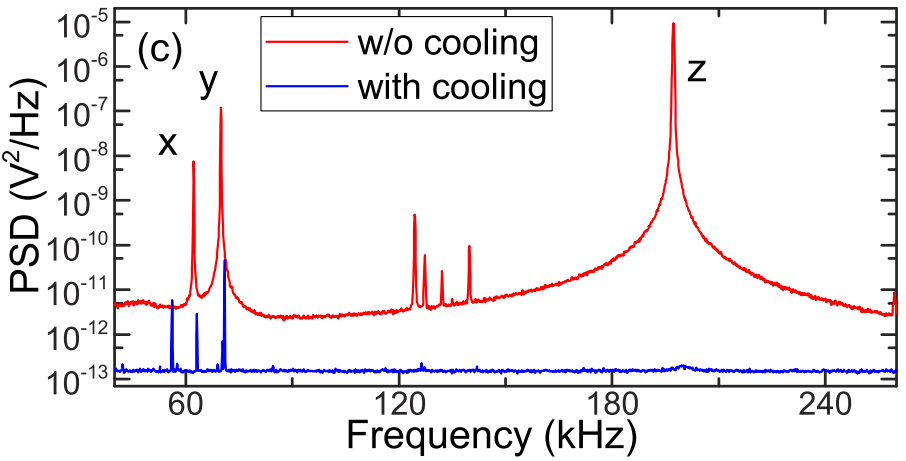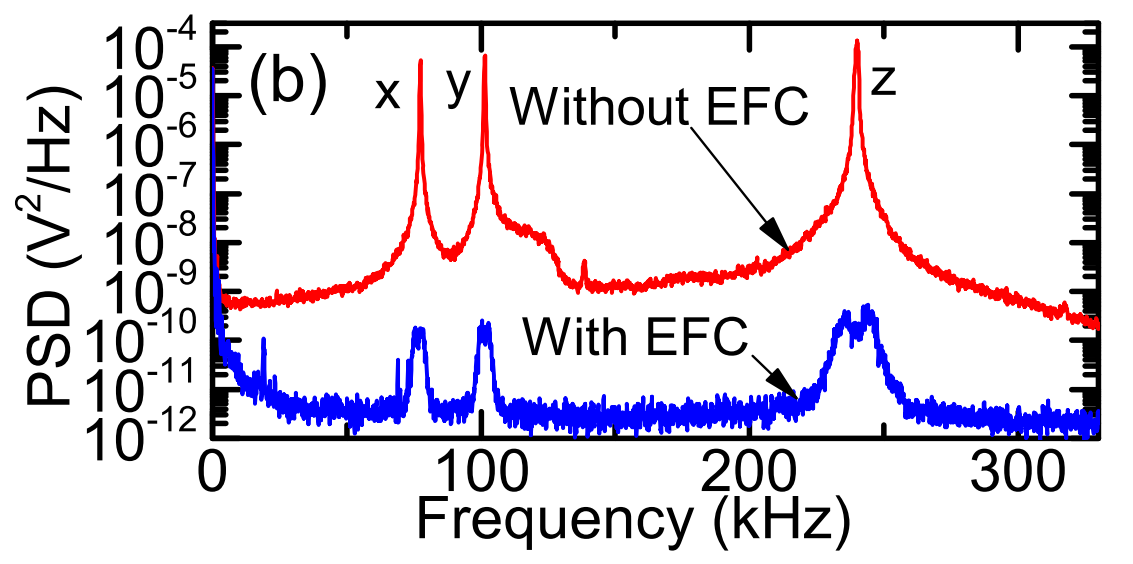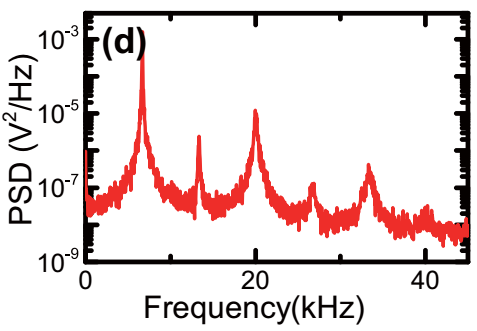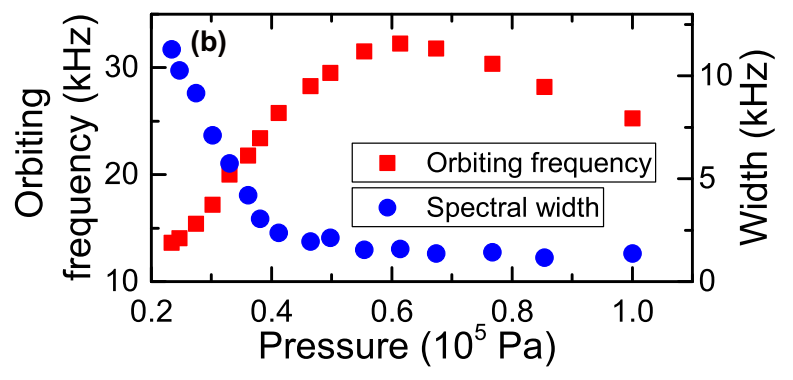Background
The background of our research is an area called optomechanics, where the motion of macroscopic objects is controlled via electromagnetic fields such as light. Over past decades, the field of cold atoms and molecules has enabled a wide variety of applications ranging from precision measurements to quantum simulations. By contrast, the field of optomechanics aims at opening up new applications by cooling the motion of nanometer- to micrometer- sized objects (Fig.1). Up to now, the specific vibrational mode of mechanical oscillators has been brought to the quantum ground state. There has been an issue that mechanical oscillators are clamped by the base plate and the quality factor, indicting the purity of oscillations, is limited.

Fig.1: Two kinds of optomechanical systems
To overcome this issue and isolate the oscillator, some groups started to explore single nanoparticles levitated in vacuum. Levitated nanoparticles are expected to be a new optomechanical system with an extremely high quality factor because of the advantage that they are very well isolated from the environment. Furthermore, nanoparticles have an advantage that their large light scattering rate enables us to observe their motion very precisely (Fig.2). Now many groups are working on various investigations such as quantum mechanical behaviours of macroscopic objects and ultrasensitive accelerometers.

Fig.2: Motion of single nanoparticles levitated in vacuum
Cooling neutral nanoparticles to the ground state
In 2020 to 2022, the technique of bringing the motion of charged nanoparticles to their ground state via electric feedback cooling, or cold damping. Our lab has developed techniques of trapping, observing, and controlling nanoparticles in an optical lattice and succeeded in cooling their motion to the ground state (Ref.1). An optical lattice is a standing wave created by retro-reflecting a laser and has been a crucial technique in the field of cold atoms. An optical lattice has various advantages such as enabling periodic potentials, facilitating explorations of quantum behaviours because of the high oscillation frequency, allowing us to modulate potentials via controlling the optical phase, and trapping multiple particles in nearby sites.
While electric feedback cooling for charged nanoparticles is a powerful cooling approach, there is an issue that nanoparticles are inevitably susceptible to electric field noises. We developed a reproducible method for neutralizing nanoparticles. In addition, we developed a new approach for all-optical feedback cooling of neutral nanoparticles and demonstrated cooling to the ground state (occupation number < 1) (Fig.2,3; Ref.2).

Fig.1: Charge neutralization of nanoparticles

Fig.2: Occupation number vs pressure

Fig.3: Power spectral density of nanoparticles. z diretion is along the optical lattice. As compared to the room-temperature curve (red line), the curve with cooling approaches the noise floor limited by the laser shot noise.
Ion trap for nanoparticles
Recently, it turns out that optical traps are not suited for capturing nanoparticles made of non-silica materials because of weak light absorption in them. We are developing a setup for trapping charged nanoparticles in an ion trap. Up to now, we have succeeded in ion-trapping silica nanoparticles in vacuum and cooling their motion (Fig.1). In future, we plan to explore the physics related to nanoparticles made of non-silica materials.

Fig.1: Nanoparticles in an ion trap
Electric feedback cooling of charged nanoparticles
We have developed a new cooling approach for nanoparticles based on the optical observation of their motion and the application of feedback electric fields synchronized to their motion (Ref.1). Fig.1 shows the power spectral density obtained from the observed motion of nanoparticles and indicates that nanoparticles are oscillating in three directions with different frequencies. As compared with the spectrum without cooling at room temperature, the spectrum with feedback cooling at a relatively high pressure of 4mPa suggests temperatures lower than 10mK in three directions. This approach is more efficient that the conventional optical cooling approach based on the parametric intensity modulation of the trapping laser and is expected to overcome the limitation of photon recoil heating and to enable cooling to the ground state. Furthermore, we established a protocol for evaluating the mass and the charge of trapped nanoparticles, which are different from particles to particles.

Fig.1: Comparison of the spectra with and without electric feedback cooling
Recently, we further extended this cooling approach and demonstrated that the motion of nanoparticles in an optical lattice can be cooled to near the ground state (Ref.2). In this paper, we observed that the motion of nanoparticles along the optical lattice is heated via the laser phase noise. By greatly reducing the laser phase noise, we showed that the heating of the motion of nanoparticles is limited only by the random photon scattering (Fig.2). Our results establish that nanoparticles in an optical lattice is also a promising playground for investigating their motion near the ground state and open up a route to exploring their quantum mechanical behaviours.

Fig.2: Observation of the heating rate of the motion of trapped nanoparticles
(a) Comparison of the observed and the measured heating rate
(b) Occupation number vs measured heating rate
References
1. M. Iwasaki, T. Yotsuya, T. Naruki, Y. Matsuda, M. Yoneda, K. Aikawa, Electric feedback cooling of single charged nanoparticles in an optical trap, Phys. Rev. A 99, 051401(R) (2019).
2. M. Kamba, H. Kiuchi, T. Yotsuya, K. Aikawa, Recoil-limited feedback cooling of single nanoparticles near the ground state in an optical lattice, Phys. Rev. A 103, L051701 (2021).
Orbital motion of two nanoparticles
Despite the simplicity of our system where nanoparticles are trapped in a focused laser beam, we sometimes encounter an unexpected behaviour. We found that nanoparticles trapped in an optical lattice exhibit strong oscillations at the atmospheric pressure (Fig.1; Ref.1). We found that this phenomenon is orbital motions of multiple nanoparticles trapped in a single lattice site. Fig.2 shows that, when the intensity of the trapping laser is modulated, two nanoparticles exhibit transitions between two states; they oscillate in a single site or they are separately trapped in neighbouring sites without oscillations.

Fig.1: Power spectral density showing the oscillation of nanoparticles

Fig.2: The oscillation starts and stops when two nanoparticles hops between two adjacent sites
While this phenomenon lasts for a few hours at the atmospheric pressure, the oscillation frequency varies and it stops when the pressures is decreased (Fig.3).

Fig.3: Oscillation frequency vs the pressure
The mechanism of this orbital motion has not been identified. Since this phenomenon is sensitive to the mass of nanoparticles, it might be useful as a nanoscale gas sensor for detecting the gases absorbed on the surface of nanoparticles.
Optical measurement of the size of nanoparticles
In experiments with nanoparticles, the sizes of trapped nanoparticles are different each time. Therefore, it is important to measure them for all the subsequent experiments. So far, the measurement of the size of nanoparticles have mainly relied on the classical approach based on their collisions with air molecules. We established a novel approach based on their interaction with light (Ref.1).
At pressures lower than a few 100 Pa, nanoparticles oscillate in a nearly harmonic potential produced with the laser. When we Fourier transform the oscillation signal and obtain the power spectral density, the spectral widths are known to be determined by the attenuation via the collisions with air molecules, implying that the widths get narrower at lower pressures. However, we observed that, in our experiment with an optical lattice, the spectral widths converge to a specific value at pressures around 10 Pa and the widths are broader along the optical lattice than the widths in other directions (Fig.1).

Fig.1: Spectral widths of nanoparticles vs pressures
We developed a theoretical model that the orientation-dependent spectral widths arise from the nonlinearity of the motion of nanoparticles and found that it agrees well with experiments. In particular, we introduce cross-dimensional coupling originating from their three-dimensional motions, which has not been included in previous models. Our model allows us to explain the spectral widths under the general situation that nanoparticles are optically trapped and sustained in vacuum.
As a result, we obtained an important conclusion that the spectral widths at low pressures normalized with the oscillation frequency directly reveals the ratio of the kinetic energy to the optical potential depth. This fact indicates that the potential depth, which is directly related to the size of nanoparticles, can be estimated from the spectral widths. In fact, we experimentally found that the normalized spectral widths are independent from the orientations and are narrower for larger nanoparticles (Fig.2).

Fig.2: Normalized spectral widths vs the size of nanoparticles
For students interested in joining our group
Our lab started in April 2015 and is still in a developing phase where students improve the existing apparatuses in ingenious manners. When involved in developing and improving apparatuses, students can learn a wide variety of experimental techniques, including electronics, optics, and vacuum systems, and achieve comprehensive understanding on the background physics. You can also experience how exciting it is to explore cutting-edge physics with the self-made apparatus. We welcome everyone who is interested in nano-physics as well as in quantum optics.